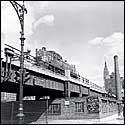
An initial proposal for the new High Line from the winning architecture team, Diller Scofidio + Renfro. (Rendering courtesy of Field Operations and Diller Scofidio + Renfro)
Like all ambitious civic schemes, especially in this byzantine city, the plan to save and reinvent the High Line—the defunct elevated freight-train viaduct extending from Gansevoort to 34th Street between Tenth and Eleventh avenues—has had to please or mollify an insanely daunting phalanx of jurisdictions and constituencies: the city, state, and federal governments, two different community boards, the giant railroad company CSX, and scores of individual property owners and tenants. And although hurdles remain—half the $100 million cost has yet to be raised—this quixotic, poetic, quasi-utopian, and altogether splendid project has gotten over the hump during 2004. “People think it’s more of a done deal than it is,” says Robert Hammond, 35, one of the pair of nobodies who undertook the impossible mission a little more than five years ago, but “yes, we went from dream to reality this year. The state and city and CSX are all onboard, and there’s been a big change in the way people think about it. It’s no longer just this crazy idea.” He expects to have a groundbreaking ceremony by the end of the new year.
And so we keep our fingers crossed. But why does this particular improbable scheme seem to be rocketing toward realization, cheered on by almost everyone?

First, as a preservationist project, it has a cool, perverse, slightly un-American kind of sensibility that appeals to this city’s creative class. The High Line is not some grand old Beaux Arts train station or banking hall that’s easy to like and to transform into cute, lucrative shops and restaurants. And we love that about it. It was never pretty or glorious, just a naked, Depression-era steel-and-concrete thing that a quarter-century of desuetude has only made more odd and homely and melancholy, an exquisite corpse. And we love that about it, too. Even after it’s spiffed up by a team of supercool designers and opened to the public as a narrow (30 to 60 feet) mile-and-a-half-long promenade, it will retain a good deal of its mad, overgrown, ruin-of-the-industrial-age quality—after all, it passes right through two buildings, like some impossible folly dreamed up by Bruce McCall in a Piranesian mode. We love all of that about it.
Second, it was the brainchild not of developers looking to make a killing, or of Olympic Games promoters, but a couple of guys who decided to try to save their neighborhoods’ stupendous ugly duckling. Throughout, Hammond (a Village painter) and his collaborator, Joshua David (a Chelsea writer), proved themselves to be not merely virtuous, but smart and shrewd and competent about politics and PR and architectural competitions.
And finally, they have been very lucky, particularly in their timing. They started Friends of the High Line just as the restaurant Pastis opened a block and a half east-northeast of the viaduct’s southern end at Gansevoort and Washington, thus certifying the still-iffy neighborhood’s destination-hipness. That was 1999, at the peak of the Wall Street boom and digital bubble, an effervescent moment when nothing seemed implausible for smart, youngish, passionate Ivy League visionaries like Hammond and David, and when an unessential urban-planning folly didn’t have to fight for attention and resources with the rebuilding of ground zero. And they were fortunate that the Giuliani regime (which approved the demolition of the High Line in late 2001) was succeeded in the nick of time by the Bloomberg regime (particularly Deputy Mayor Dan Doctoroff and planning director Amanda Burden), which has committed $43 million to creating, as Hammond puts it, “a monument to the fact that you can get crazy things done.”